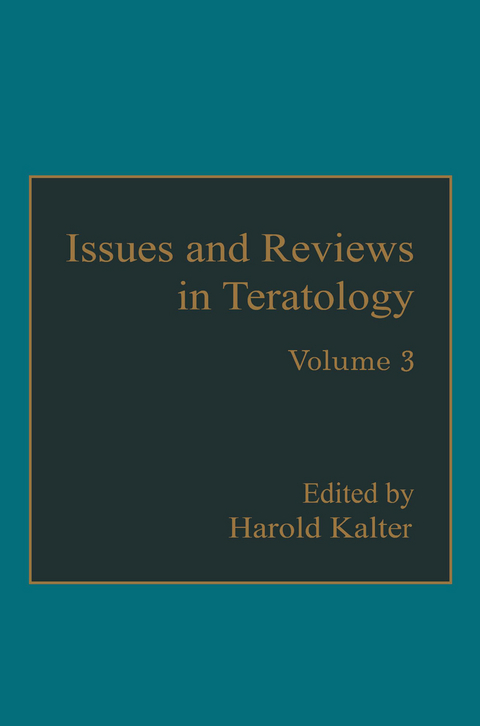
Issues and Reviews in Teratology
Springer-Verlag New York Inc.
978-1-4612-9510-5 (ISBN)
There is still no clear understanding of what causes the great majority of human congenital malformations. And since in most sorts of human disease and pathology that yet prevail prevention usually awaits understanding of cause, it is generally thought that the same is true of developmental aberrations. But is this true? For the relatively few congenital malformations whose causes are primarily environmental, it is plain that their discovery has enabled prevention, but not nec essarily immediately. It took a generation from the time of the discovery that maternal rubella was teratogenic to learn how to immunize against it. Much debate occurred before it was appreciated that thalidomide was a teratogen, and only its removal from the pharmacist's shelf and the end of the epidemic of limb defects attributed to the drug overcame the last doubts. For other proven environmental teratogens doubts and difficulties still con tinue. The claimed prevalence of fetal genital distortions due to female sex hor mones may have been exaggerated. Some potentially teratogenic therapeutic drugs, like anticoagulants, anticonvulsants, and anticancer chemicals, are still pre scribed despite this danger because of their benefits to pregnant women. For those congenital malformations whose basis is predominantly genetic or chromosomal it is different, however. Prevention has not been achieved by the discovery of such causes, as dramatic and revolutionary as some of them have been, except in the questionable sense of interference with reproduction by genetic coun seling or prenatal elimination. But this has not inhibited the romanticists.
1 The Role of the Obstetrician in the Prevention and Treatment of Birth Defects.- 1. Introduction.- 2. The Abnormal Conceptus.- 3. Causes of Birth Defects.- 4. Screening for Congenital Anomalies.- 5. Diagnosis of the Abnormal Conceptus.- 6. Management of the Abnormal Conceptus.- 7. The Future.- References.- 2 The Nature and Causes of Spontaneous Abortions with Normal Karyotypes.- 1. Introduction.- 2. Mechanisms of Abortion.- 3. Incidence of Chromosomally Normal Abortuses.- 4. Clinically Implicated Causes of Spontaneous Abortion.- 5. Summary.- 6. Conclusions.- References.- 3 Temporal Trends in Twinning.- 1. Introduction.- 2. Time Trends in Twinning Rates.- 3. The Etiology of Twinning. Some Recent Findings.- 4. The Physiological Mechanism of DZ Twinning.- 5. Hypotheses Related to the Decrease in Twinning Rates.- 6. Conclusion.- References.- 4 Cytogenetic and Clinical Significance of Fragile Sites on Human Chromosomes.- 1. Introduction.- 2. Fragile Sites on Autosomes.- 3. Fragile Site on the Human X Chromosome (Xq27).- 4. X-Linked Mental Retardation without Cytogenetic Manifestation.- 5. Concluding Remarks.- References.- 5 Informative Morphogenetic Variants: Minor Congenital Anomalies Revisited.- 1. Background.- 2. Terminology; Definition.- 3. Quantification of Informative Morphogenetic Variants (IMV): Formal and Comparative Aspects.- 4. The Biology of Informative Morphogenetic Variation.- 5. The Specific and Nonspecific Value of Informative Morphogenetic Variants, Singly and in Combination.- 6. The Use of Specific Aggregates of Informative Morphogenetic Variants for Diagnostic Purposes.- 7. The Application of Numerical Taxonomy to Informative Morphogenetic Variants for the Purposes of Classification and Nosology.- 8. Informative Morphogenetic Variants As Indices of Teratogenic Environments.- 9. How Can the Information Value of Morphogenetic Variants Be Increased?.- 10. The Positive Prognostic and Dysmorphogenetic Significance of Informative Morphogenetic Variants.- 11. Informative Morphogenetic Variants As Components of Predictive Scores for Nonspecific Detection of Congenital Disorders Not Apparent at Birth.- 12. The Value of Informative Morphogenetic Variants in Late Childhood- or Adult-Onset Disease.- 13. Informative Morphogenetic Variants As Sentinel Phenotypes for Monitoring Environmental Teratogenic Hazards in Populations.- 14. Summary.- 15. Epilogue.- References.- 6 The Mouse Trisomies: Experimental Systems for the Study of Aneuploidy.- 1. The Generation of the Mouse Trisomies.- 2. Properties of the Mouse Trisomies.- 3. Mouse Trisomies As Models for Studying the Effects of Aneuploidy and Human Chromosomal Disorders.- References.- 7 Embryonic Induction and Teratology of the Developing Skin and Oral Mucosa.- 1. Introduction.- 2. Embryonic Induction.- 3. Genetic Defects and Mutants As Models for Experimental Studies.- 4. Molecular Teratology: Virus-Induced Genetic Lesions.- 5. Summary.- References.- 8 Fine Structure of Hereditary Defects of the Central Nervous System in Mice.- 1. Introduction.- 2. Sources of Mutant Material.- 3. Methods of Study.- 4. Mouse Mutants.- 5. Other Mutants.- 6. Conclusion.- References.- 9 The Role of Mammalian Embryo Culture in Developmental Biology and Teratology.- 1. Introduction.- 2. Culture Techniques.- 3. Uses of the System.- 4. Disadvantages of the Culture System.- References.
| Erscheint lt. Verlag | 27.9.2011 |
|---|---|
| Zusatzinfo | XIV, 300 p. |
| Verlagsort | New York, NY |
| Sprache | englisch |
| Maße | 152 x 229 mm |
| Themenwelt | Sachbuch/Ratgeber ► Natur / Technik ► Naturführer |
| Medizin / Pharmazie ► Medizinische Fachgebiete ► Gynäkologie / Geburtshilfe | |
| Studium ► 2. Studienabschnitt (Klinik) ► Humangenetik | |
| Naturwissenschaften ► Biologie ► Genetik / Molekularbiologie | |
| ISBN-10 | 1-4612-9510-6 / 1461295106 |
| ISBN-13 | 978-1-4612-9510-5 / 9781461295105 |
| Zustand | Neuware |
| Haben Sie eine Frage zum Produkt? |
aus dem Bereich


